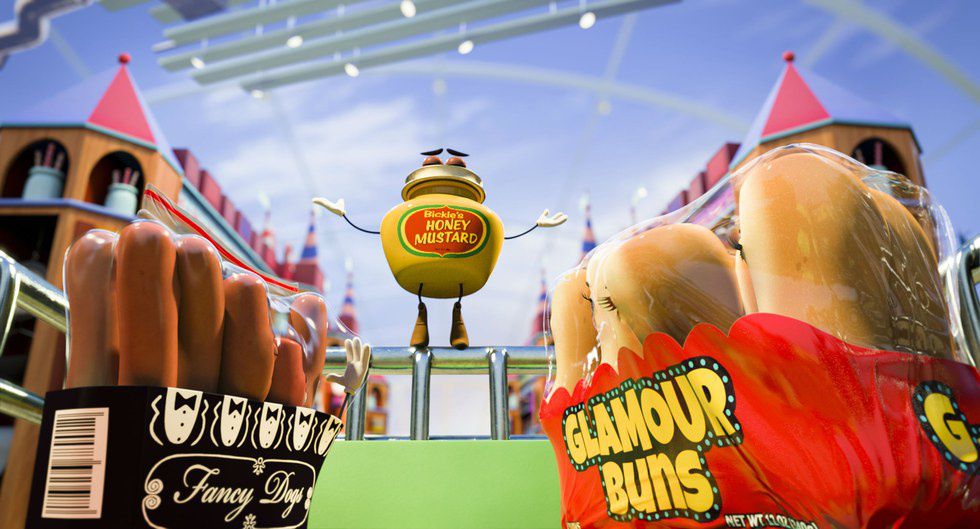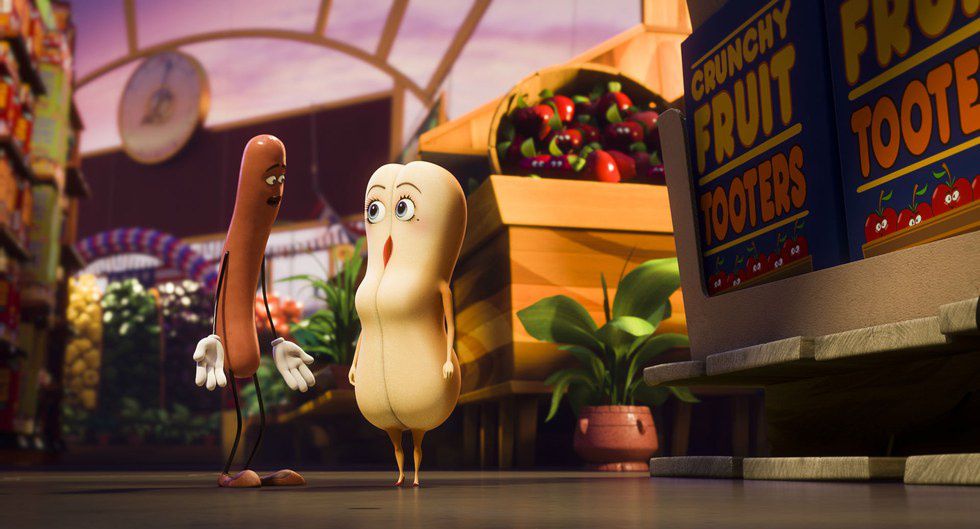★★★★☆ (8/10)
It's a bit pointless to hold any film from the minds of Seth Rogen and Co. in high regard. Complaining that his movies are too juvenile is like complaining about the corny nature of the early 007 films. If you walk into anything written by and/or starring the Canadian comedian, you should be ready to hear the same old shtick. "Sausage Party" finds Rogen and his entourage of celebrity actors and stand-up favorites giving us more or less of what we've heard them all say in other efforts. F-bombs fill every sentence, while weed gags and sex jokes are littered throughout. This time, however, the raunch and offensiveness is turned up to 11, as this R-rated work of 3D animation takes plenty of jabs at Disney, Pixar, DreamWorks, and the world at large. It is the most shamelessly offensive and gleefully filthy-minded movie of its kind since "South Park: Bigger, Longer & Uncut."
At a grocery store called Shopwell's, every food item longs to be chosen by us (their gods) and taken to our homes ("The Great Beyond"). When a bottle of honey mustard (Danny McBride) is returned by a customer, he warns his friends that they are in mortal danger once they leave the supermarket. Curious about this warning, Frank (Seth Rogen), a hot dog, seeks out the truth from Firewater (Bill Hader), an old bottle of Native American liquor. Once he realizes that everything food has been led to believe is a lie, Frank hurriedly prepares his friends, including love interest Brenda (Kristen Wiig), a hot dog bun, and all the other food in the store to unite against the humans before they meet their horrible fate.
I'm not joking around when I say that "Sausage Party" is very much in the same vein as the "South Park" movie. Without stating all the obvious similarities, I will say that this film, like "South Park" before it, is more than likely to provoke movie theaters into keeping all underage viewers from sneaking into it. The major difference between the two is how "Sausage Party" handles its cultural, religious and sociopolitical commentaries that underline its more conventional storyline. Rogen, along with longtime co-writer Evan Goldberg (and co-star Jonah Hill, who shares a story credit with the duo), never uses the film's satirical edge to its full potential, opting for more of what his films are used to showcasing whenever ideas run thin. You might not think it, but yes, even a movie about talking food finds a way to have its edible characters smoke weed, though I must admit that the use of a kazoo in lieu of a miniature bowl is cute.
Rogen and his pals may not be as adventurous as the film's premise suggests (I imagine that he's doing his best to avoid a riotous controversy similar to the one that doomed the release of "The Interview" two years back), but he and the conceptual artists channel a good amount of the film's creative side into some of the character design. The most tongue-in-cheek look is that of Brenda, who is given vertical lips (need I say more?). Other humdingers include Sammy Bagel Jr. (Edward Norton, doing a damn good Woody Allen impression), whose mouth is also his hole, and the Stephen Hawking-esque Gum. Most of the other foods simply have arms, legs and faces slapped onto them in various ways, but the voices behind them amplify the character their designs may lack. Hader is, as usual, a natural with multiple accents, pitches and intonations. Paul Rudd is unrecognizable as the manager of Shopwell's, or as the food call him, "The Dark Lord." Nick Kroll has a ball voicing an actual douche, even though the character itself serves as a lazy excuse for a central villain. Michael Cera shines as Barry, another hot dog who is plagued with personal insecurities concerning his deformity.
As good as the cast sounds, I never once found myself actually rooting for Frank or any of his friends, but I realize that is kind of the point. Since we humans have no real emotional attachment to food in the first place, it makes their inevitable demise all the more amusing (as twisted as that sounds, but that is also the point). It's the opposite effect of Pixar efforts like "Toy Story," and it works remarkably well. But like the film's other ideas, this concept doesn't go full throttle. We see food chewed up, sliced, chopped, and devoured, but how do they react while being mixed together into breakfast, lunch and dinner for their gods to consume? This is hinted at, but is shoved aside to make room for Rogen's litany of sexual innuendos and pot puns.
So why have I rated "Sausage Party" so high? The truth is plain and simple: It made me laugh...a lot...and really hard too. I haven't laughed this much during a movie in a long time, which is worth something if you ask me. Much of my enjoyment stems from one of its final scenes, which takes a popular term coined by feminist critic Rosalind Coward to intensely literal extremes. (Props to those of you who know what I'm talking about even if you have yet to see the film.) The film does have its shortcomings, which, mind you, are not negated by all the belly-laughs I had, but if something as silly as "Sausage Party" can make you question its integrity and yet still split your sides anyway, then that's a winner in my book.






















